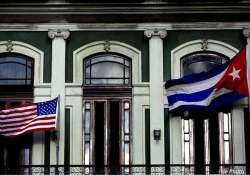Cuba's reopened embassy in US to fly original vintage flag
Havana (Washington) : The Cuban government is preparing to reopen its embassy in Washingtonon Monday with the original Cuban flag that was taken down in 1961, when the two nations cut off ties.In a move heavy with

Havana (Washington) : The Cuban government is preparing to reopen its embassy in Washingtonon Monday with the original Cuban flag that was taken down in 1961, when the two nations cut off ties.
In a move heavy with symbolism, the flag to be raised during the inauguration ceremony is the one that was lowered on January 3, 1961, when the Cuban diplomatic mission in the US closed, reported Xinhua.
The national standard was brought back to Cuba and preserved by historian Eusebio Leal Spengler. The scholar will be among the 30 Cuban citizens invited to the embassy opening ceremony on Monday.
Cuba and the US will reopen their respective embassies as part of their recent agreement to restore diplomatic ties.
The agreement placed the two countries on the path toward the normalization of relations, and during the process the two sides have to use political wisdom so as to find solutions to problems that have accumulated in the last 50-plus years, Cuban President Raul Castro said Wednesday in a speech to legislators.
Cuba's historic flag will again fly atop the nearly 100-year-old neoclassical mansion in the Adams Morgan district of Washington that has housed Cuba's Interests Section, basically a pared-down embassy then President Fidel Castro and his US counterpart Jimmy Carter agreed to establish in the late 1970s in lieu of embassies.
The mansion was built in 1916 during the government of then Cuban President Mario Garcia Menocal (1913-21) to serve as the Legation of the Republic of Cuba, a type of diplomatic mission headed by a lower ranking representative than an ambassador.
The first Cuban diplomat who headed the legation was Carlos Manuel de Cespedes Quesada, son of Carlos Manuel de Cespedes, known as the "Father of the Cuban Homeland".
Cespedes Quesada hired local architectural firm MacNeil and MacNeil to construct the French-style mansion described by the National Register of Historic Places in the US as "one of the most imposing and enigmatic residences" in the US capital.
The three-story limestone building features an impressive facade with two towers, and an inner marble staircase topped by a cupola with beautiful stained glass.
On the main floor, six side doors leading to offices each display the shield of one of the six original provinces ofCuba: Pinar del Rio, Havana, Matanzas, Santa Clara, Camaguey and Oriente.
Since 2011, the top floor houses an intimate bar, accessible by invitation only, which bears the name of the USauthor Ernest Hemingway, who lived in Cuba.
The legation was turned into an embassy in 1923, during the administration of President Alfredo Zayas (1921-25), and closed briefly in 1952, following a coup that temporarily ousted Fulgencio Batista (1940-44, 1952-59).
It continued to serve as a diplomatic mission until January 1961, when Washington decided to sever ties with Cuba after revolutionary Fidel Castro toppled Batista and came to power.
The mansion did not escape Cold War upheaval. In June 1978 a Cuban right-wing terrorist group, CORU, threw an explosive at the site. The worst attack took place a year later when a similar group, Omega 7, detonated a bomb at the rear of the building.
After US President Barack Obama and Raul Castro announced on December 17, 2014 that they would work to restore diplomatic relations, the house underwent a rapid renovation, which included placing a flagpole to hoist the island's flag.